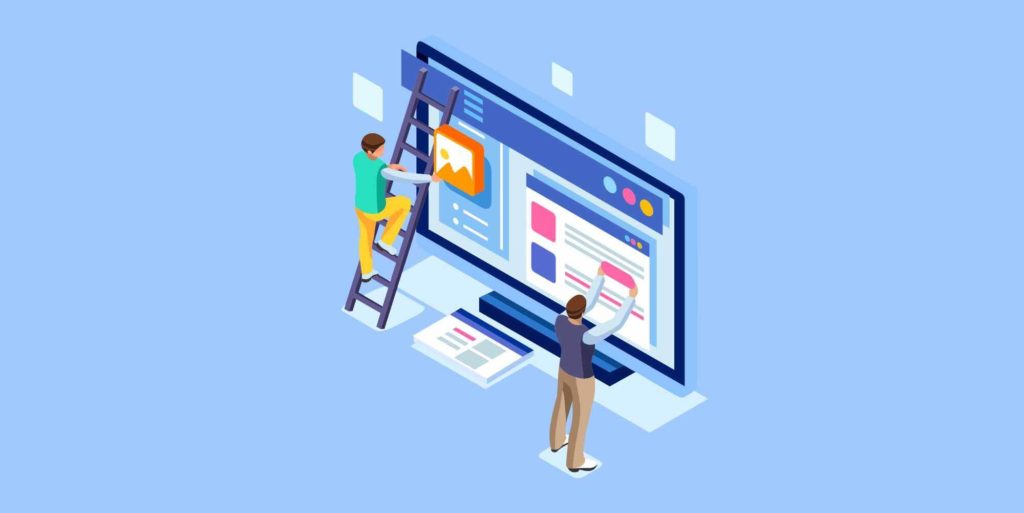Want to improve your website design to increase sales and provide a better company image? Here’s 21 ways to do just that!
Website design doesn’t need to be complicated. A few tweaks could improve your user experience and help you to increase sales. If you want to grow your business long-term, you will need to optimise your website using SEO tools to ensure your website appears in search results.
In this guide…
- Don’t use stock images
- Use visuals, but optimise them!
- Choose a drag-and-drop website builder
- Consider using sales funnels
- Don’t mix your messaging
- Use simple, clear CTAs
- Have a clean page organisation
- Consider deleting carousels (unless you’re in ecommerce)
- Avoid annoying pop-ups
- Use translation plugins
- Avoid annoying autoplays
- Use mobile responsiveness
- Check your loading times
- Highlight testimonials or social proof
- Choose “flat” design templates
- Add text to your images
- Use white space
- Make hyperlinks stand out
- Easy social share and follow buttons
- Separate key info with bullet points
- Keep web pages consistent
1. Don’t use stock images

Stock images are non-custom photos made by photographers and graphic designers. For example, when you sign up with a website builder, there will be a selection of free theme templates that have stock images on its pages.
These might look like a great way to improve your website design at first, but can seem non-unique and unoriginal. Tests show that people are unconvinced by stock images. For example, Visual Website Optimiser found 161% more visitors clicked its homepage article when a real photo was used (rather than a stock image).
If you’re selling a product or letting people know about you and your brand, consider using a real photo. Or a service that can create cheap custom images for you that do not look like stocks (because they’re not really).
2. Use visuals, but optimise them!
Articles with visuals were found to get 94% more views than those with no visuals. But using non-optimized media, especially if your hosting plan is very basic, means longer loading times. If a website takes more than a second to load, your visitors could be up to 32% more likely to simply leave.
To avoid this and improve your website design:
- Test your speeds: Test My Site
- Compress visuals with a compression tool or WordPress plugin
- Outsource hosting/delivery of your media with a Content Delivery Network like Cloudflare.
3. Choose a drag-and-drop website builder
Website building tools help you build a website by using a simple ‘drag-and drop’. This means there is no need to know programming or even basic web development. Everything is pre-designed so that you can pick up the tool and very quickly get moving.
If you’re looking to create a new website, or improve your website design, then a website builder is a great option for quickly and easily creating a professional looking site. If you’re looking to create an eCommerce website to sell online, we recommend Shopify. Check out this review for more information.
4. Consider using sales funnels
“Sales funnels” can get quite complicated and confusing, so here’s a guide for you that simplifies how to lead people to your product or service.
Remember that people need to be led. This will make your CTA (call to action) more effective. And the tools in that link above will make the process straightforward, perhaps increasing your conversions by 64%.
Considering your sales funnel is an important way to improve your website design.
5. Don’t mix your messaging
Web design is about setting expectations. How you present information influences how it’s received. You need to lead in this, as people don’t have the time to figure you out.
This doesn’t mean you need to be a professional writer. Bloggers like Seth Godin use a clear, minimalistic, and straightforward style of writing. His blog posts are almost never more than a few hundred words — and usually a lot less. The key is to keep things to-the-point and skimmable as most people only skim-read.
6. Use simple, clear CTAs
Are your CTAs (calls to actions) clear and obvious? Your CTA is the section where you ask the visitor to take a step forward in engaging with your product or service. Look at the Audible screenshot above. Instantly, the visitor knows what to do in order to learn more about your product or to purchase it.
The CTA usually comes towards the end of the fold. Make it obvious and straightforward. Clear CTAs are an important way to increase sales and improve your website design.
7. Have a clean page organisation
Are you trying to be too clever? When somebody visits your page, they want to know where the About, Product, and Blog sections are. Keep your navigation headings simple so that visitors do not need to figure out too much — too much creativity will lead to more hesitancy, increasing the odds of them clicking out of the webpage.
Here’s a cool heatmap tool which lets you see which parts of the site visitors use most.
8. Consider deleting carousels (unless you’re in ecommerce)
Carousels on websites often do not work as people simply don’t click them. For Instagram, carousels are incredible. But a study by Harrison Jones for Search Engine Land found that nobody clicks and carousels on webpages. Unless you’re running an ecommerce website, perhaps it’s best to avoid it.
9. Avoid annoying pop-ups
Aggressive pop-ups are bad for conversions (the one exception could arguably be if somebody is already trying to leave your website, but even then you may be reducing the chance that they will return).
Consider using tools with pop-up variations. These will let you do things like making a pop-up that appears in a small portion of the screen, only after a visitor scrolls past a certain percentage of your page — or one that is in the sidebar.
10. Use translation plugins
If you are looking to expand internationally, translation plug-ins make your services or products easily available to people in more places across the globe — this may increase your sales and online success. Maybe there are audiences you are missing.
If you want to seriously target a specific audience, consider hiring a professional translator and creating a subdomain with copy that has been translated into that language. Professionals may be best in this instance, to avoid any embarrassing mistakes and help you improve your website design.
11. Avoid annoying autoplays
When you hover over a Netflix Original title, it begins playing. Very few websites can get away with this however. Your business is probably not as big as Netflix and people may not be there to specifically watch videos or to listen to music. Annoying visitors with loud, blaring music that they do not know how to turn off may drive them away.
12. Use mobile responsiveness
Mobile responsiveness boosts SEO because more than 50% of online surfers are using a mobile device of some kind to surf — that’s an increase from 16.2% in 2013.
Assume that many people will experience of your website through a mobile device, eg. a tablet, Android, etc. Make sure that your webpage template is mobile responsive.
13. Check your loading times
Does your site load under 2 seconds? We mentioned earlier that a loading time of over 1 second could lead to a 32% increased chance of the visitor leaving your webpage before it fully loads.
Pingdom lets you check your website speed. GTmetrix and PageSpeed Insights are two other options. Whatever your loading time is, perhaps you can improve it incrementally by getting a better hosting plan or optimising media.
Making your website faster is an important way to improve your website design.
14. Highlight testimonials or social proof
Do you have a way to quickly boost customer confidence? Humans are designed to be social creatures — we pay attention to the opinions of others. If you want people to comment more on your website, place previous comments higher up on your homepage; or use a testimonial/review from a current customer.
Whenever you can, show a picture of the customer or client who gave you the review, just ask permission first. Go for simple fonts there are easy to read.
15. Choose “flat” design templates
Do you have a flat website design? Over the past few years, flat design has become more popular and a good choice if you want to improve your website design. This is because it’s especially good for user experiences on apps and websites, boosting conversions.
Flat designs minimise textures, drop shadows, and gradients — keeping things minimalistic and two-dimensional. This is especially good for mobile experiences.
We recommend this as a great way to improve your website design: focus on sharp shapes, vibrant colours, and interesting illustrations. Flat designs load faster and are more flexible to different platforms, leading to more effective SEO.
16. Add text to your images
There’s a reason memes have become so popular. While images tell a thousand words, sometimes this is too many. Using both together can be a bigger win.
Adding text to images is a simple way to quickly focus the viewer on exactly what you want them to pay attention to. For example, using a caption or a free online annotation service to add descriptions to images, turning them into diagrams.
17. Use white space
White space indicates distance / relationships between elements in the graphic. The golden rule of using white spaces to maintain proper relationships between different components in a design.
For example, a headline and its subtitle should be closer together compared to its distance with another headline. This quickly lets the visitor know what information pieces are grouped together. Also, in the digital information age, using lots of whitespace is a minimalistic design style, that makes your information feel calmer.
18. Make hyperlinks stand out
Hyperlinks lead to new webpages. You need to make it clear when you’re linking. Differentiate with colours, underlining, and so on. You do not need to use the traditional blue with an underline. But it should stand out from the main text. You could also make your links a colour different to expectations like the orange image above.
19. Easy social share and follow buttons
How quickly can somebody share your materials? “User-generated content” (UGC) is one means of content marketing. Make this as simple as possible. The logic behind it is that you allow (and encourage) users to produce and share content related to your website.
This includes forum posts, shares, creations using your tools, comments — all of this is free material that directly leads to your website (content that you haven’t had to produce).
20. Separate key info with bullet points
Bullet points let visitors get all the information they need quickly (problems, benefits, solutions, features, and so on) — all in a short amount of time. Use these to chunk up information in articles or product descriptions.
21. Keep web pages consistent
More colours isn’t always better. But consistency is a very important part of branding. You match things together: Colours, fonts, heading sizes, buttons, spacing, and other design elements.
Once again, consider using a website builder, which offers cheap and fast templates that you can populate with your own information.
FAQs
1. How do I create a professional personal website?
The truth is that website-creation has a spectrum that stretches from simple to unbelievably difficult. There are plenty of tutorials promising an amazing personal website in thirty minutes.
This is rarely true unless you use a drag and drop website builder. Use these to actually save time. Although WordPress is simpler than some others, it is by no means easy to use for a non-developer.
2. How do I create my own website?
You will need a good web host. Visit our articles, where we break down how to go about this in a simple way. Also, if you value your time more than money, consider paying for a web designer or choosing a simple ‘drag-and-drop’ builder like Weebly or Shopify.
Also, know your goals and budget before starting. For example, can you afford a web designer? Do you need to worry about ranking for keywords?
3. How can I make my website look professional & attractive?
Keep your layout simple, make the navigations simple to follow, and make sure that the call-to-action stands out near the bottom but without the visitor needing to scroll down. Web design is complicated — therefore choose a template that already has a great design which you don’t need to reconfigure.
Does your website comply with data protection law? Check out this easy guide to make sure your business is safe!
If this guide helped you improve your website design, please recommend DigitalSupermarket.





